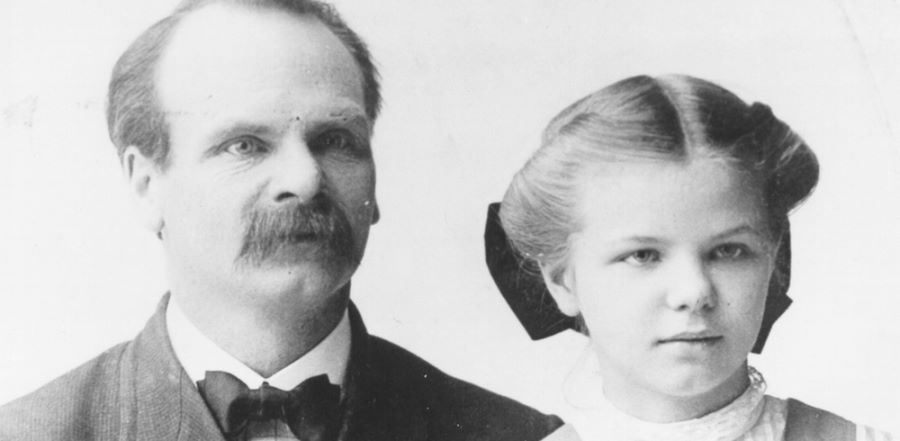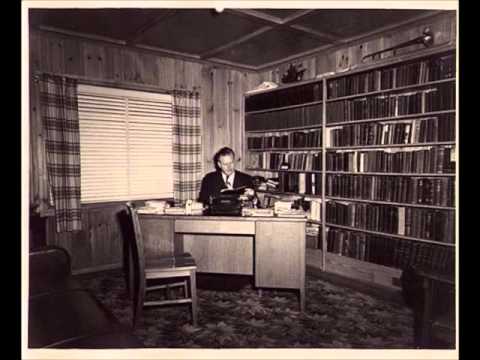Click to join the conversation with over 500,000 Pentecostal believers and scholars
Click to get our FREE MOBILE APP and stay connected
| PentecostalTheology.com




This Week in AG History — August 22, 1954
By Darrin J. Rodgers
Originally published on AG-News, 24 August 2023
Carl M. “Daddy” Hanson (1865-1954), a spiritual father to many early Pentecostals on the northern Great Plains, earned his Pentecostal stripes on both sides of Azusa Street. He experienced the Pentecostal distinctive of speaking in tongues in the 19th century, and he became an early leader in the Assemblies of God in the first half of the 20th century.
The son of Norwegian immigrants to Minnesota, Hanson was converted while a student at Augsburg Seminary and became an evangelist affiliated with the Scandinavian Free Mission (now known as the Evangelical Free Church). The Scandinavian Free Mission, in the 1890s and early 1900s, witnessed a significant revival in which many people experienced salvation, healings, and biblical spiritual gifts such as speaking in tongues.
This revival made a deep impression on Hanson, who himself was healed of a terminal illness in 1895. A short time later, he held services in Grafton, North Dakota, where people had a great hunger for God. There, he saw a young Norwegian girl, enraptured in the presence of God, speak in a language she had not learned. Hanson pondered what it meant, studied Scripture, and came away convinced that that the prophecy in Joel 2:28 was coming true before his eyes: “And it shall come to pass afterward, that I will pour out my spirit upon all flesh; and your sons and your daughters shall prophesy, your old men shall dream dreams, your young men shall see visions.”
Hanson continued as an itinerant evangelist. His daughter, Anna Berg, recalled, “My father began giving testimony wherever doors were open to him: in churches, schoolhouses, homes, and missions. The response was amazing. Everywhere people were saved. This was usually followed by a consuming desire for more of God’s power in their lives.”
In about 1899, Hanson received the gift of speaking in tongues. In 1904, he opened a rescue mission in Minneapolis, where he sought to give physical and spiritual help to those who were drunken, homeless, and destitute. He traversed the region, raising support and seeking young people to work with him at the mission.
Hanson soon identified with the emerging Pentecostal movement in Chicago, which had its roots in the 1906 Azusa Street revival in Los Angeles. Chicago Pentecostal leader William Durham ordained Hanson in 1909, and Hanson transferred his ordination to the Assemblies of God in 1917. In 1922, when the Assemblies of God organized churches and ministers in Minnesota, Wisconsin, and the Dakotas into the North Central District, participants unanimously elected Hanson to serve as the district’s first chairman.
Hanson and his wife, Mathilda, had 13 children, two of whom became Pentecostal missionaries. Esther M. Hanson served at L.M. Anglin’s orphanage in China, and Anna C. (Mrs. Arthur F.) Berg served in Belgian Congo prior to pastoring in Sisseton and Sioux Falls, South Dakota. Former Assemblies of God General Superintendent G. Raymond Carlson also traced his family’s Pentecostal experience back to Hanson’s ministry. It was in Carlson’s maternal grandparents’ home in Grafton, North Dakota, that Hanson first saw someone speak in tongues.
Hanson’s story reminds us that the modern Pentecostal movement emerged from a variety of sources. Revivals at Topeka and Azusa Street may have been two of the most visible focal points of early 20th-century American Pentecostalism, but prior revivals, including those among Scandinavian settlers in the northern Great Plains, provided precedents and leaders for the emerging movement.
The Pentecostal Evangel published a memorial tribute to Hanson on page 12 of the Aug. 22, 1954, issue.
Also featured in this issue:
• “Tony, the ‘Miracle Boy’”
• “Maybe I’m Wrong,” by John Garlock
• “Ride on, King Jesus,” by Zelma Argue
And many more!
Click here to read this issue now.
Read more about Hanson in the article, “Carl M. Hanson: Scandinavian Harbinger of Pentecost,” in the Spring-Summer 2006 issue of Assemblies of God Heritage magazine.
Pentecostal Evangel archived editions courtesy of the Flower Pentecostal Heritage Center.
Do you have Pentecostal historical materials that should be preserved? Please consider depositing these materials at the Flower Pentecostal Heritage Center (FPHC). The FPHC, located in the Assemblies of God national offices, is the largest Pentecostal archive in the world. We would like to preserve and make your treasures accessible to those who write the history books.
Flower Pentecostal Heritage Center
1445 North Boonville Avenue
Springfield, Missouri 65802 USA
Phone: 417.862.1447 ext. 4400
Toll Free: 877.840.5200
Email: archives@ag.org
Website: www.iFPHC.org
“The New World of Realities in Which We Live”:
How Speaking in Tongues Empowered
Early Pentecostals
Gary B. McGee
Assemblies of God T eological Seminary, 1435 North Glenstone Ave.,
Springfield, Missouri 65802, USA
gmcgee@agseminary.edu
Histories of Pentecostalism have recounted how early adherents anticipated preaching in their newfound languages until disappointing reports from missionaries trickled home. Yet, in the years from 1901 to 1908, many Pentecostals recognized the value of glossolalic utterances to include languages not only for preaching but also as a means of prayer, with the latter especially denoting their willingness to step beyond the border of rational spirituality into the realm of Christian mysticism. At the same time, they addressed the connection of Spirit baptism to love in the Spirit-filled life and struggled with questions that arose about the meaning of the gift of interpretation. This essay proposes that the early literature reveals a consistently held role for adoration and prayerful intercession that enabled the faithful to withstand the impact of other changes in meaning.
Pentecostalism, speaking in tongues, Spirit baptism
Introduction
“We wanted power from on high to help save the world,” declared Charles Parham matter-of-factly to a newspaper reporter as he reviewed the events of the January 1901 revival at his Bethel Bible School in Topeka, Kansas. “We prayed for it; we received it.”1 To Parham and his band of followers, who embraced his novel teaching on the baptism in the Holy Spirit, the Charles F. Parham, quoted in “New Religion ‘Discovered’ at ‘Stone’s Folly’ Near Topeka,” Topeka Mail and Breeze, February 22, 1901; in Larry Martin, ed., The Topeka Outpouring of 1901, rev. ed. (Joplin, MO: Christian Life Books, 2000), 219.
Mary Johnson (1884–1968) and Ida Anderson (1871–1964) are described in pentecostal historiography as the first pentecostal missionaries sent from America. Both of these Swedish-American missionaries experienced baptism of the Spirit, spoke in tongues, and were called as missionaries to Africa by God, whom they expected to speak through them to the native people. They went by faith and completed careers as missionaries to South Africa. But who were these two figures of which relatively little has been written? They were Swedish-American “Free-Free” in the tradition of August Davis and John Thompson of the Scandinavian Mission Society—the first Minnesota district of the Swedish Evangelical Free Mission, known today as the Evangelical Free Church of America. This work examines the lives of these two female missionaries, their work in South Africa, and their relationship with Swedish Evangelical Free churches in America, particularly its pentecostal stream of Free-Free (frifria).


Anonymous
David Rollings I did attempt to check your reference after David Bundy Peter Vandever Bishop Bernie L Wade commented on this post There are NO facts in the Link you posted apart from some communistic references to the Ruski – BTW the Mollokans did speak in tongues way prior to even moving to Azusa as we have indicated in our online talks with Dr Robeck – – – so what are you saying by asking to check the FACTS ? are you saying Rodger Deering is wrong in his AG article this week? Along with McGee Terry Wiles Maccia and myself who have researched and proven tongues in America prior to Azusa ? Have you done similar research in our American archives or is this forced and juxtaposed personal opp. with no ground? Are you saying there were NO tongues in America prior to America or tongues did not exist after ACTS period? What exactly are you saying – wish you post your paper in the group so we can ask you more questions //THANKS
https://www.pentecostaltheology.com/speaking-in-tongues-in-america-prior-to-the-azusa-street-ourcog/
Histories of Pentecostalism have recounted how early adherents anticipated preaching in their newfound languages until disappointing reports from missionaries trickled home. Yet, in the years from 1901 to 1908, many Pentecostals recognized the value of glossolalic utterances to include languages not only for preaching but also as a means of prayer, with the latter especially denoting their willingness to step beyond the border of rational spirituality into the realm of Christian mysticism. At the same time, they addressed the connection of Spirit baptism to love in the Spirit-filled life and struggled with questions that arose about the meaning of the gift of interpretation. This essay proposes that the early literature reveals a consistently held role for adoration and prayerful intercession that enabled the faithful to withstand the impact of other changes in meaning.
Pentecostalism, speaking in tongues, Spirit baptism
Introduction
“We wanted power from on high to help save the world,” declared Charles Parham matter-of-factly to a newspaper reporter as he reviewed the events of the January 1901 revival at his Bethel Bible School in Topeka, Kansas. “We prayed for it; we received it.”1 To Parham and his band of followers, who embraced his novel teaching on the baptism in the Holy Spirit, the Charles F. Parham, quoted in “New Religion ‘Discovered’ at ‘Stone’s Folly’ Near Topeka,” Topeka Mail and Breeze, February 22, 1901; in Larry Martin, ed., The Topeka Outpouring of 1901, rev. ed. (Joplin, MO: Christian Life Books, 2000), 219.
Mary Johnson (1884–1968) and Ida Anderson (1871–1964) are described in pentecostal historiography as the first pentecostal missionaries sent from America. Both of these Swedish-American missionaries experienced baptism of the Spirit, spoke in tongues, and were called as missionaries to Africa by God, whom they expected to speak through them to the native people. They went by faith and completed careers as missionaries to South Africa. But who were these two figures of which relatively little has been written? They were Swedish-American “Free-Free” in the tradition of August Davis and John Thompson of the Scandinavian Mission Society—the first Minnesota district of the Swedish Evangelical Free Mission, known today as the Evangelical Free Church of America. This work examines the lives of these two female missionaries, their work in South Africa, and their relationship with Swedish Evangelical Free churches in America, particularly its pentecostal stream of Free-Free (frifria).
Anonymous
PS on the Link you posted I did see a reference to Keswick: a Bibliographic Introduction to the Higher Life Movements
2012 David Bundy
who knows a little something about British, European and Swedish Pentecostal history and I agree with his references almost 100% – Deering is also of some Nordic descent and grew up in the Dakotas and MN so heS done his homework as well before publishing the AG article David Rollings Peter Vandever
Anonymous
We wrote about those speaking in other tongues previous to the Topeka Outpouring in the Parham book. https://www.amazon.com/Legacy-Charles-Sarah-Eleanor-Parham/dp/195225325X